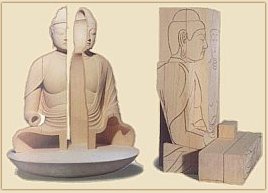|
THIS IS A SIDE PAGE
Return to Main Page on MAKING BUDDHA STATUES
Yoseki Zukuri 寄木造
Also read Yosegi Zukuri.
Also called Kiyose Zukuri 木寄造 or Yoseai Zukuri 寄合造
 A major carving technique introduced in the later half of the 10th century. Up until then, statues were carved from a solid block of wood using a technique called ichiboku-zukuri 一本造. The new yoseki-zukuri technique reached its apogee with Unkei (1148 - 1223 AD), one of Japan’s most highly acclaimed sculptors. Instead of using one solid piece of wood, Unkei and his team carved the statue in a piecemeal fashion from partially hollow blocks of wood. First, the individual body parts were roughly and separately carved. Second, the pieces were assembled, and only then, thirdly, did detailed carving begin. A major carving technique introduced in the later half of the 10th century. Up until then, statues were carved from a solid block of wood using a technique called ichiboku-zukuri 一本造. The new yoseki-zukuri technique reached its apogee with Unkei (1148 - 1223 AD), one of Japan’s most highly acclaimed sculptors. Instead of using one solid piece of wood, Unkei and his team carved the statue in a piecemeal fashion from partially hollow blocks of wood. First, the individual body parts were roughly and separately carved. Second, the pieces were assembled, and only then, thirdly, did detailed carving begin.
This new method had various advantages. Not only was it faster, allowing several artists to work in tandem on different parts, but also the final sculpture was much lighter than one carved from a single block of wood. And, in the centuries that followed, the prefabricated nature of the individual body parts allowed temples to quickly repair or replace damaged or destroyed body parts -- e.g., placing the undamaged head of an older statue (whose body was ruined by fire or earthquake) onto another statue whose body was still in good repair.
Some Japanese sources say the yosegi-zukuri method was introduced in the later half of the 10th century, due primarily to the lack of large trees and a growing creative impulse to create gigantic statues of the Nyorai and Bosatsu.
Others say the technique stems from Jōchō, the great Buddhist sculptor (died 1057 AD) who is credited with the outstanding Bosatsu on Clouds carvings found at Byodo-in Temple.
 Single-block carvings are also known as natabori 鉈彫 (literally “hatchet carving”), but they are differentiated from ichiboku-zukuri carvings by the characteristic round chisel (nata 鉈) markings left on the statue’s surface. Natabori images are rough-cut (arabori 荒彫) or fine-cut (kozukuri 小造り) without undergoing the finishing (shiage 仕上げ) process, and for this reason, some Japanese claim that natabori are unfinished works, while others claim that natabori statues are a unique sculptural style. Single-block carvings are also known as natabori 鉈彫 (literally “hatchet carving”), but they are differentiated from ichiboku-zukuri carvings by the characteristic round chisel (nata 鉈) markings left on the statue’s surface. Natabori images are rough-cut (arabori 荒彫) or fine-cut (kozukuri 小造り) without undergoing the finishing (shiage 仕上げ) process, and for this reason, some Japanese claim that natabori are unfinished works, while others claim that natabori statues are a unique sculptural style.
In the Edo Period, two wandering artists of great fame revived this technique. They were the Buddhist priest Enkū 円空 (1632-1695) and the Zen priest Mokujiki Myōman 木食明満 (1718-1810). Nearly all of their extant pieces were carved from a single block of wood, including the pedestals, and were not hollowed out. This gives their pieces a freshness that is completely different from the refined works of traditional Buddhist sculpture.
For many more details on making statues, and the techniques and materials used, please see MAKING BUDDHIST STATUES.
Historical Notes on Buddhist Iconography
Buddhist iconography and artwork first came to Japan via mainland Asia in the Asuka Period (approx. 538 - 710 AD), with the earliest sculptures mostly imported from China and Korea. In subsequent years, as the Japanese made their own sculptures, the resulting pieces looked almost identical to their Chinese and Korean counterparts. Buddha statues in those early years, for example, are extremely skinny. (See Japanese Buddhist Statuary in All Eras for details.) However, by the Kamakura Era (1186 to 1316 AD), the Japanese were lending their own artistic and spiritual interpretation to Buddhist artwork, and a sense of realism takes hold. Sculptures of the Kamakura Period are renown for their realism and lifelike proportions. Artists of that era also began using quartz crystals for the eyes, making the Buddha face appear almost alive. For the first time ever, Kamakura artists began carving various deities nude, such as Jizo and Benzaiten. Lifelike portrait paintings of founding masters and important monks, especially among the Zen sects, became popular as well during the Kamakura Era.
THIS IS A SIDE PAGE
Return to Main Page on MAKING BUDDHA STATUES
|